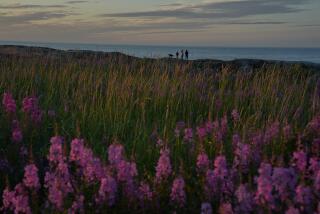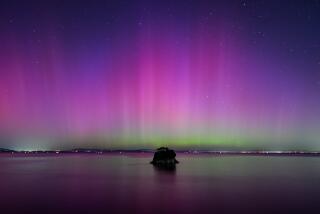Want to see the northern lights? A plane trip in Canada’s Yukon takes you up close
- Share via
WHITEHORSE, Canada — As I waited on the airport tarmac about midnight in Whitehorse, capital of Canada’s Yukon Territory, I shivered, a combination of the 8-degree air and my excitement. I was about to find out whether my new strategy for seeing the northern lights would work.
Several friends had traveled to the far north to see the mysterious colorful lights, but it either snowed every night or the aurora borealis didn’t occur. They returned home disappointed.
I was hoping for a sure thing, so I searched for a tour operator that would guarantee its guests would see the dazzlers. Like most of life, no trip came with guarantees. But the Aurora 360 Experience seemed as close to fail-safe as you can get, especially when you’re trying to view a natural phenomenon that depends on the sun’s electrons bashing into Earth’s electrons. I booked it for my husband, Paul, and me.
That’s how we ended up with 50 others boarding a chartered Air North 737-500 jet one night in February 2019.
Kalin Pallett, our Aurora 360 Experience leader, said astronomers and space-weather forecasters had combed 20 years of aurora borealis data and chose Feb. 7 as the best night for seeing the northern lights above Whitehorse. The company chartered a jet for that night — and for Feb. 8 as a backup. Even if it were cloudy or snowing, we would see them while flying six miles up.
What if the lights were a no-show both nights? Pallett had packed the four-night Aurora 360 Experience with on-the-ground activities to steep guests in the culture, nature and allure of the Yukon. Even if we didn’t check off the big-ticket item on our bucket list, Pallett promised we’d go home happy.
I hoped he was right.
Flight to the lights
When our plane leveled at 36,000 feet, the pilot shut off the interior and exterior lights. Like moviegoers in a darkened theater, the passengers fell silent.
Twenty minutes into our flight I heard an excited voice over the PA: “There they are! The aurora borealis!”
The passengers cheered. Flight attendants served Yukon gin cocktails with glowing-green plastic ice cubes.
For the next three hours we took turns pressing our faces to the windows and sharing our joy at what we saw. The ethereal green glow sometimes hovered above the horizon and sometimes spread throughout the sky. Its movement was so gradual that it seemed like a dream.
When passengers complained that their pictures paled compared with the real thing, Canadian nature photographer Neil Zeller offered tips on how to photograph the lights. (“Instagram has spoiled us,” he said.)
I gave up on my iPhone camera and turned to the window, determined to etch the northern lights into my memory.
Mush!
Upon returning to Earth after our lights fantastic, we rolled into bed about 4 a.m., and when the alarm rang later that morning, I was as groggy as a college student who had crammed all night for finals.
The near-zero air outside zapped me wide awake. Dressed in my rented Arctic gear — insulated parka, bib-overall snow pants, boots and mittens — and looking like the Michelin Man, I climbed into a van for our excursion to the Sky High Wilderness Ranch, set among mountains dotted with spruce trees.
The train trip across Canada was a chance to see the land before it collapses in on itself.
The yapping of 150 Alaskan huskies told me we’d arrived in time for dog-sled rides. The musher (from marche, the French word for “go”) gave me a choice: I could huddle under a blanket and enjoy the scenery while she mushed the dogs, or I could mush them myself. I was up for a Yukon adventure. She gave me a quick lesson on how to stand on the back of the sled, hang on and let the dogs run. If I wanted to stop them, I could dig my boot into the snow.
The dogs raced along an icy path through the forest and across a frozen lake. When they picked up speed on a curve, I panicked. I jammed my boot into the snow, but it didn’t stop the dogs. Barking, they shot me a look that said, ‘Lady, what’s your problem?’” I hung on and let them go for it.
First Nations tales
That night we dined at Whitehorse’s Kwanlin Dun Cultural Centre, a gathering place for descendants of the Yukon’s First Nations people. Dancers in wooden raven masks depicted ancient legends; then Gramma Susie, a First Nations poet, read some of her work. She said people saw the northern lights as a reflection of their ancestors’ spirits.
“When I was 13, my grandma warned me to stay inside at night or they would take me with them to cure their loneliness,” she said. “I think she was just trying to keep me home and out of trouble.”
Near midnight, Pallett recommended we take a van to an empty field about 30 miles from town used for aurora borealis sightings. “You will see how most tourists experience the northern lights,” he said. “It takes a lot of patience.”
Paul and I soon found ourselves among groups of tourists in Arctic parkas. We couldn’t see their faces in the dark but we heard Portuguese and Chinese. They hustled back and forth between heated yurts and the edge of the field, where they had set up cameras on tripods. The sky was blanketed with stars; there was no hint of green. I took refuge from the cold in a yurt.
Two hours and several cups of hot chocolate later, I heard cheers. I stepped outside to observe a ribbon of green light snaking slowly across the horizon. Cameras clicked. Then the green faded to black. One hour and another cup of hot chocolate later, I joined fellow travelers in a van back to town. Paul insisted on hanging out in case the northern lights reappeared. When he rolled into bed at 3 a.m., he murmured that it had been a wash.
Glass-blowing, moose and musk oxen
Our last day in Whitehorse we viewed Gold Rush artifacts at the MacBride Museum, then strolled along the snowy banks of the Yukon River. Despite the below-freezing temperature, the door to Lumel glass-blowing studios was wide open. Owner Lu Baker-Johnson beckoned us in to warm up.
“This is the only place in Whitehorse that leaves its door open in the winter,” she said. I understood why as I walked over to the 2,100-degree furnace. I peeled off my parka and accepted her offer to blow glass.
Baker-Johnson guided my hands on the punty, a stainless-steel rod for shaping molten glass. “I invite homeless people — locals call them ‘river walkers’ — to stop in to warm up,” she said. “As long as they’re ‘solid’ — their hands aren’t shaking — they are welcome to blow glass. The creativity clears their minds.” Under Baker-Johnson’s gentle direction I discovered the thrill of her craft.
That afternoon our group toured the Yukon Wildlife Preserve, a 700-acre home to 12 species of northern Canadian animals. They were rescued from the wild because they were orphaned or injured. I admired fluffy white Arctic foxes and a silver-furred lynx, and giggled at a moose that had shed its antlers for the winter and looked as though it was, well, missing something.
I was most taken by the musk oxen, the size of small bison, whose thick fur reached the snowy ground. A guide explained that fossils of musk oxen ancestors indicate that they had migrated to this region across the Bering land bridge from Siberia more than a million years ago.
After dark we visited the Royal Astronomical Society of Canada Yukon Observatory, a two-room building atop a hillock in a forest. Whitehorse is an ideal spot to study the stars, Pallett said, because its air is among the cleanest in the world, according to the World Health Organization. On the observation deck I peered through the 11-inch telescope at a sliver of moon etched with craters. They seemed close enough to touch.
We trudged through the forest to the Tahkini Hot Pools, following a path of glow sticks planted in the snow. The therapeutic qualities of the mineral-rich hot springs were discovered in 1907, but First Nations people used them long before that. “In the 1940s when the U.S. Army was building the Alaska Highway, work crews would come out here for a soak,” Pallett said.
In the locker room I traded my Arctic gear for a bathing suit, stepped into the cold and plunged into the pool. The water, heated to 107 degrees, was heavenly. I could make out the shadowy figures of other visitors up to their chins in the water. Their eyebrows, lashes and hair were frosted with ice.
Pallett had recommended we look for the northern lights while we were soaking. I peered into the sky through the steam rising off the pool. No glimmer of green, but the extraordinary wonder of stars was enough.
If you go
THE BEST WAY TO WHITEHORSE, CANADA
From LAX, Air Canada offers connecting service (change of planes) to Whitehorse. Restricted round-trip airfare from $821, including taxes and fees.
Aurora 360 Experience, (778) 776-2406, aurora-360.ca. From about $2,840 per person, double occupancy. Includes hotel, meals and chartered flight as well as hot springs, dog sledding, wildlife preserve and observatory excursions. Departures Jan. 23-27, 2020, and Feb. 11-15, 2021.
More to Read
Sign up for The Wild
We’ll help you find the best places to hike, bike and run, as well as the perfect silent spots for meditation and yoga.
You may occasionally receive promotional content from the Los Angeles Times.






